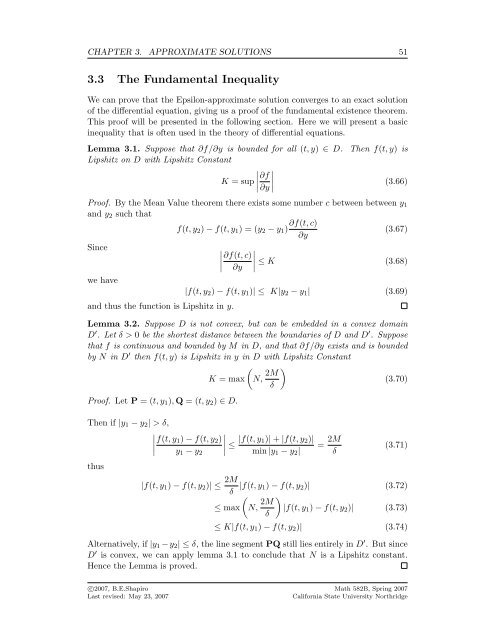The Computable Differential Equation Lecture ... - Bruce E. Shapiro
The Computable Differential Equation Lecture ... - Bruce E. Shapiro
The Computable Differential Equation Lecture ... - Bruce E. Shapiro
Create successful ePaper yourself
Turn your PDF publications into a flip-book with our unique Google optimized e-Paper software.
CHAPTER 3. APPROXIMATE SOLUTIONS 51<br />
3.3 <strong>The</strong> Fundamental Inequality<br />
We can prove that the Epsilon-approximate solution converges to an exact solution<br />
of the differential equation, giving us a proof of the fundamental existence theorem.<br />
This proof will be presented in the following section. Here we will present a basic<br />
inequality that is often used in the theory of differential equations.<br />
Lemma 3.1. Suppose that ∂f/∂y is bounded for all (t, y) ∈ D. <strong>The</strong>n f(t, y) is<br />
Lipshitz on D with Lipshitz Constant<br />
K = sup<br />
∂f<br />
∣ ∂y ∣ (3.66)<br />
Proof. By the Mean Value theorem there exists some number c between between y 1<br />
and y 2 such that<br />
∂f(t, c)<br />
f(t, y 2 ) − f(t, y 1 ) = (y 2 − y 1 ) (3.67)<br />
∂y<br />
Since ∣ ∣∣∣ ∂f(t, c)<br />
∂y ∣ ≤ K (3.68)<br />
we have<br />
and thus the function is Lipshitz in y.<br />
|f(t, y 2 ) − f(t, y 1 )| ≤ K|y 2 − y 1 | (3.69)<br />
Lemma 3.2. Suppose D is not convex, but can be embedded in a convex domain<br />
D ′ . Let δ > 0 be the shortest distance between the boundaries of D and D ′ . Suppose<br />
that f is continuous and bounded by M in D, and that ∂f/∂y exists and is bounded<br />
by N in D ′ then f(t, y) is Lipshitz in y in D with Lipshitz Constant<br />
(<br />
K = max N, 2M )<br />
(3.70)<br />
δ<br />
Proof. Let P = (t, y 1 ), Q = (t, y 2 ) ∈ D.<br />
<strong>The</strong>n if |y 1 − y 2 | > δ,<br />
∣ f(t, y 1 ) − f(t, y 2 ) ∣∣∣<br />
∣<br />
≤ |f(t, y 1)| + |f(t, y 2 )|<br />
= 2M y 1 − y 2 min |y 1 − y 2 | δ<br />
thus<br />
(3.71)<br />
|f(t, y 1 ) − f(t, y 2 )| ≤ 2M δ |f(t, y 1) − f(t, y 2 )| (3.72)<br />
(<br />
≤ max N, 2M )<br />
|f(t, y 1 ) − f(t, y 2 )| (3.73)<br />
δ<br />
≤ K|f(t, y 1 ) − f(t, y 2 )| (3.74)<br />
Alternatively, if |y 1 −y 2 | ≤ δ, the line segment PQ still lies entirely in D ′ . But since<br />
D ′ is convex, we can apply lemma 3.1 to conclude that N is a Lipshitz constant.<br />
Hence the Lemma is proved.<br />
c○2007, B.E.<strong>Shapiro</strong><br />
Last revised: May 23, 2007<br />
Math 582B, Spring 2007<br />
California State University Northridge
















